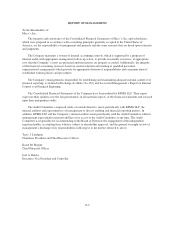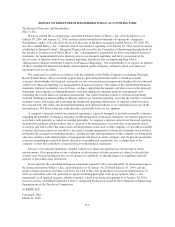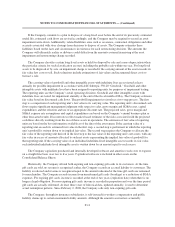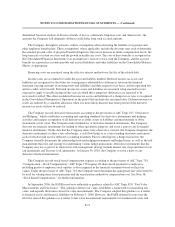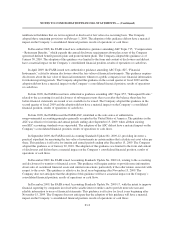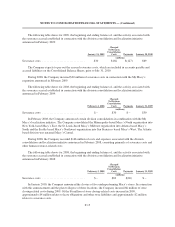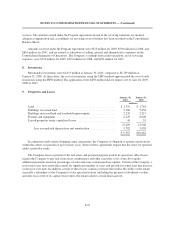Macy's 2009 Annual Report Download - page 59
Download and view the complete annual report
Please find page 59 of the 2009 Macy's annual report below. You can navigate through the pages in the report by either clicking on the pages listed below, or by using the keyword search tool below to find specific information within the annual report.
NOTES TO CONSOLIDATED FINANCIAL STATEMENTS — (Continued)
If the Company commits to a plan to dispose of a long-lived asset before the end of its previously estimated
useful life, estimated cash flows are revised accordingly, and the Company may be required to record an asset
impairment write-down. Additionally, related liabilities arise such as severance, contractual obligations and other
accruals associated with store closings from decisions to dispose of assets. The Company estimates these
liabilities based on the facts and circumstances in existence for each restructuring decision. The amounts the
Company will ultimately realize or disburse could differ from the amounts assumed in arriving at the asset
impairment and restructuring charge recorded.
The Company classifies certain long-lived assets as held for disposal by sale and ceases depreciation when
the particular criteria for such classification are met, including the probable sale within one year. For long-lived
assets to be disposed of by sale, an impairment charge is recorded if the carrying amount of the asset exceeds its
fair value less costs to sell. Such valuations include estimations of fair values and incremental direct costs to
transact a sale.
The carrying value of goodwill and other intangible assets with indefinite lives are reviewed at least
annually for possible impairment in accordance with ASC Subtopic 350-20 “Goodwill.” Goodwill and other
intangible assets with indefinite lives have been assigned to reporting units for purposes of impairment testing.
The reporting units are the Company’s retail operating divisions. Goodwill and other intangible assets with
indefinite lives are tested for impairment annually at the end of the fiscal month of May. The Company estimates
fair value based on discounted cash flows. The goodwill impairment test involves a two-step process. The first
step is a comparison of each reporting unit’s fair value to its carrying value. The reporting unit’s discounted cash
flows require significant management judgment with respect to sales, gross margin and SG&A rates, capital
expenditures and the selection and use of an appropriate discount rate. The projected sales, gross margin and
SG&A expense rate assumptions and capital expenditures are based on the Company’s annual business plan or
other forecasted results. Discount rates reflect market-based estimates of the risks associated with the projected
cash flows directly resulting from the use of those assets in operations. The estimates of fair value of reporting
units are based on the best information available as of the date of the assessment. If the carrying value of a
reporting unit exceeds its estimated fair value in the first step, a second step is performed, in which the reporting
unit’s goodwill is written down to its implied fair value. The second step requires the Company to allocate the
fair value of the reporting unit derived in the first step to the fair value of the reporting unit’s net assets, with any
fair value in excess of amounts allocated to such net assets representing the implied fair value of goodwill for
that reporting unit. If the carrying value of an individual indefinite-lived intangible asset exceeds its fair value,
such individual indefinite-lived intangible asset is written down by an amount equal to such excess.
The Company capitalizes purchased and internally developed software and amortizes such costs to expense
on a straight-line basis over two to five years. Capitalized software is included in other assets on the
Consolidated Balance Sheets.
Historically, the Company offered both expiring and non-expiring gift cards to its customers. At the time
gift cards are sold, no revenue is recognized; rather, the Company records an accrued liability to customers. The
liability is relieved and revenue is recognized equal to the amount redeemed at the time gift cards are redeemed
for merchandise. The Company records income from unredeemed gift cards (breakage) as a reduction of SG&A
expenses. For expiring gift cards, income is recorded at the end of two years (expiration date) when there is no
longer a legal obligation. For non-expiring gift cards, income is recorded in proportion and over the time period
gift cards are actually redeemed. At least three years of historical data, updated annually, is used to determine
actual redemption patterns. Since February 2, 2008, the Company sells only non-expiring gift cards.
The Company, through its insurance subsidiaries, is self-insured for workers compensation and public
liability claims up to certain maximum liability amounts. Although the amounts accrued are actuarially
F-11



